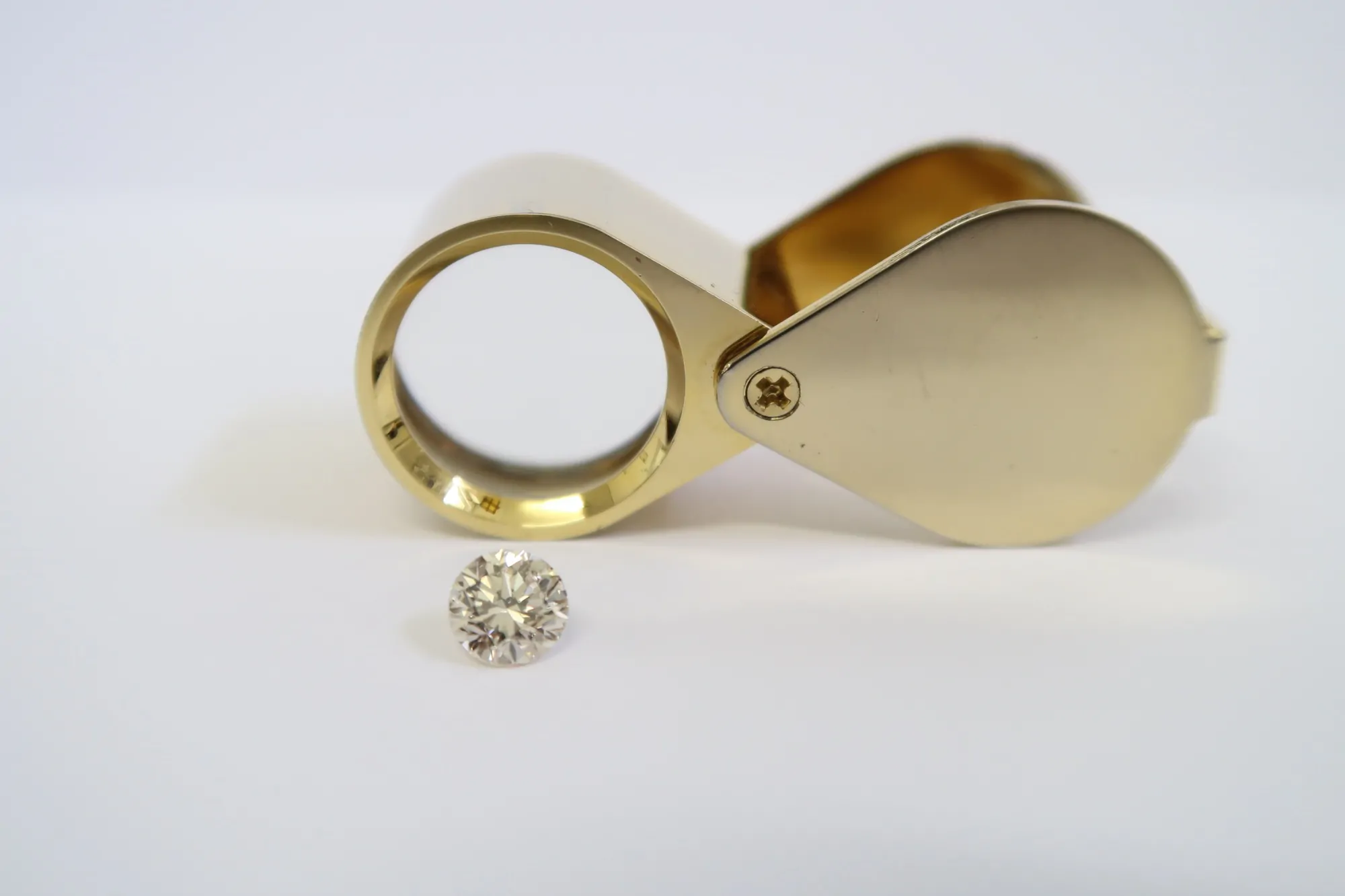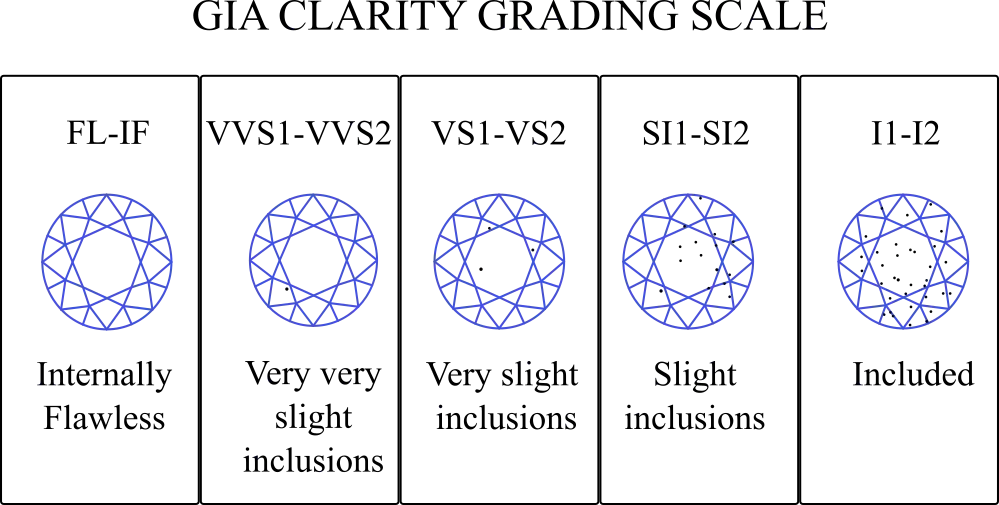
Table of Contents
As Jewelry Shopping Guide editors, we write about things that we love and we think you’ll like too. We often have affiliate partnerships, and may generate some revenue from these links at no cost to you.
The diamond clarity grade ranges from Internally Flawless to Included, with the Included grades (1, 2 and 3) being the least desirable.
While there can sometimes be a hidden gem among the Included grades, as we’ve outlined in our article on I1 clarity diamonds, in general, it’s best to avoid I2 diamonds.
But what’s so wrong with I2 diamonds and why don’t most retailers carry them?
Let’s take a look at I2 diamonds in depth and whether they’re good or bad for your jewelry choices.
What Are I2 Diamonds?
I2 is a diamond clarity grade that sits low on the diamond clarity scale. For those new to this topic, a diamond’s clarity is determined by the presence or lack thereof of any blemishes, inclusions, cavities, feathers, or graining in the diamond.

100% clear diamonds are graded as IF (Internally Flawless) or FL (Flawless), diamonds with minor and inclusions invisible to the naked eye are graded VVS1 & VVS2 (Very Very Slightly Included), diamonds with inclusions more prominent but still almost always invisible to the naked eye are graded as VS1 & VS2 (Very Slightly Included), ones with even bigger inclusions sometimes visible to the eye are referred to as SI1 & SI2 (Slightly Included) and diamonds which almost always have painfully obvious inclusions are called I1, I2 & I3 (Included Diamonds).
I2 clarity diamonds, therefore, fall in the middle of that lowest of all clarity tier of diamonds. That means that they have an abundance of clearly visible inclusions in them, whether blemishes, grains, cavities or others.
These inclusions can be very unpleasant to look at, especially when they end up being clustered together at a key location in the stone or when they are darker in color. They can also affect the brilliance and the sparkle of the diamond as they can obstruct the light’s reflection inside the stone.

In other words, if you want a clear, beautiful, sparkling and brilliant diamond on your jewelry, I2 stones are not what you should be looking at.
Another issue with I2 diamonds is their durability and structural integrity. It’s not just that these diamonds look unsightly in general, but also that they may easily fracture and break due to the weakened composition from the many inclusions.
I1 vs I2 – What’s the Difference?

Despite all that, if Included diamonds are divided into sub-categories, one would assume that there is some difference between them, right?
I1 diamonds, just like I2, have a great many and considerably large inclusions in them. Unlike I2, however, I1 still has a minuscule chance for these inclusions to be nearly eye-clean, meaning – invisible to the naked eye.
It’s very rare for an I1 stone to be eye-clean, so don’t hold your breath. You’d have to look for a stone where the inclusions are colorless, not clustered together, in such positions in the stone as to not hamper light performance, and their shapes should more or less match the diamond’s cut. In general, this is very difficult to find.

You may find I1 and I2 stones that aren’t unsightly, but more often than not, they would be cloudy with little transparency. An I2 diamond lacks the brilliance traditionally associated with diamonds. You’d have to spend such an enormous amount of time and effort to find a nearly eye-clean I2 stone that you’d be much better off just buying a more expensive SI1, SI2 or VS2 stone.
I2 vs I3 – Should I Avoid Both?
So, if I1 are still noticeably better than I2, then are I3 that much worse, right? Well, yes – I3 diamonds contain more inclusions and less transparency than I2 clarity diamonds.
However, we won’t try to twist this in an “I2 is better” direction because the simple conclusion is that both I2 and I3 should be avoided for any piece of jewelry on which the diamonds are intended to be noticeable.
Why Don’t Some Retailers Sell I2 Diamonds at All?
With all we said above about I2 clarity diamonds, it shouldn’t come as a surprise that most of the prominent retailers out there simply don’t bother selling them. Retailers like James Allen, Blue Nile, Brian Gavin, and many other retailers that we’d usually recommend buying diamonds from don’t sell loose I2 stones simply because they aren’t regarded as “high quality” diamonds.
This isn’t to say that some retailers don’t sell jewelry with small side stones or melee diamonds that would technically be categorized as I2 clarity stones, but even that won’t always be the case. When it comes to main piece diamonds on a ring or another piece of jewelry, however, or a loose diamond, you can expect not to find any I2 stones in a lot of the better vendors.
Do I2 Diamonds Have Any Value in Jewelry?
If I2 diamonds are so worthless why are we even bothering with them? I2 and even I3 stones can sometimes find purpose in some pieces of jewelry. Some obscure diamond jewelry designs that have stones covered in metal ornaments, for example, don’t really need the diamond to be particularly clear.
Side stones and melee stones, as we mentioned, also don’t need to be too clear as they too small to be looked at individually.
Still, many would say that even a side or a melee stone should be clearer so that it has better brilliance and sparkle properties, and we’d agree. But, nevertheless, that’s one way in which I2 diamonds can have value in jewelry.
How to Buy Diamond Rings with Low Clarity Grades?
Whether you’re looking for an I2, I1 or I3 clarity diamond, it’s important to know how to choose and buy it. The fact that these stones are of such a low clarity grade doesn’t mean that you shouldn’t pay attention when you buy. Even an I2 stone can vary from looking Almost OK to God-awful depending on its inclusions.
So, if you don’t want to waste your money on a hard-to-look-at stone you should pay extra attention to what you’re buying. Generally, we’d always advise you to use prominent and trustworthy online retailers such as James Allen and Blue Nile as they offer HD quality images and 3D videos, but as they don’t sell I2 diamonds, that’s off the table.
Sites like Etsy sometimes have beautiful artisan or vintage jewelry featuring I2 diamonds. Communicate clearly with the seller and ask for information about the stone. View the diamond carefully via clear images and video, if possible. Check to see how it interacts with light and whether there are any large inclusions on the table of the diamond.
Wrapping Things Up…
I2 diamonds are so far down the clarity grading scale that a lot of people write them off altogether. While with I1 you can still find some value and purpose, and even the occasional nearly eye-clean stone, I2 diamonds seem like a lost cause. They do find some purpose here and there in the jewelry world, but we’d basically advise you to steer clear of them if you want an engagement ring or a piece of jewelry that’s brilliant and attractive.









